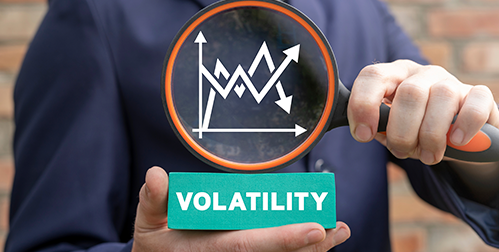High Volatility is the New Normal
Stable and predictable markets seem to be a thing of the past. Volatility is the new rule of the day. It stems from the rapid increase in global uncertainty. Investors are shifting strategies with each change. We are living in the aftermath of a pandemic and through a war in Ukraine. Uncertainty is the only thing investors can be certain of.
Volatility is how much the stock market moves up or down compared to normal. If the S&P 500 rises or falls by more than 1% over a sustained amount of time, we consider the market to be volatile.
Gargi Chaudhuri is head of iShares Investment Strategy at Blackrock. He says the market is already extremely volatile. The S&P 500 was down 8.39% in June, bringing its YTD return down 20.58%. The Dow Jones Industrial Average lost 6.71% for the month and was down 15.31% YTD.1 With a few bounces thrown in, the markets are meeting the definition of volatile. Chaudhuri advised investors to “get used to a more a volatile world in the months and years ahead.”2
Leon Kalvaria is Citi’s Institutional Client Group Chairman. He shares Chaudhuri’s sentiment. Kalvaria warned that “days of unbelievable volatility will continue on here for a while until we settle out.”3 Recent trading sessions have proven him correct.
Sources of Uncertainty
Inflation – Investors are uncertain of when and if inflation will end. As a result, some are jumping in and out of the market. The Labor Department revealed that inflation grew more than expected. It hit a new four-decade high in June. Surging food, energy, and goods prices risk cutting consumer spending over time. Reduced consumer spending could send stock prices downward. Investors worry lingering inflation might cause the Fed to tighten monetary policy even more than forecast.
Interest rates– The Federal Reserve is fueling volatility with interest rate increases. Higher interest rates erode the present value of future corporate cash flows. Stocks are lower this year in response to higher rates. Simply, higher rates and tighter monetary policies have caused stocks to go down.
Some investors are hedging their bets that the Fed will give up on rate hikes. To them, lower stock prices become buying opportunities. There is no clear sign on how the Fed will deal with the tradeoff between growth and inflation.
Corporate Earnings – Call it the gift of low expectations. S&P earnings are down 8%. But stock reactions after some of those bad reports have been positive. Traders had priced their pessimism into the market. And when actual earnings weren’t AS bad as expected, it was considered a positive. Kalvaria commented, “So from an earnings standpoint, people are getting comfortable with what I call the ‘new normal.’” 4
Companies seem to be in a good position to weather a downturn. But no one knows when the downturn will happen, how bad it will be, or how long it will last. Volatile prices are reflecting a hope for the best, expect the worst scenario.
Global Events – The world has become a much more chaotic and uncertain place. The Ukraine War is pushing inflation higher. Global supply chains are still snarled. The level of global debt is reaching record heights. The International Monetary Fund estimates it is at 256% of global gross domestic product.5 China is still struggling to get the pandemic under control. And they’ve just recently had to call in tanks to stop runs on rural banks. There is a fear that China’s slowdown and chaos will drag down the entire global economy. 6
When Will Prices Stabilize
The stock market might continue to be volatile for some time. Economic uncertainty shows no signs of letting up any time soon. Ideally, stock prices should stabilize when they find the level where longer-term investors are willing to own and hold them. Volatility typically remains elevated until that price floor is found.
Ultimately, investors shouldn’t try and time the market. The best way to deal with whipsawing stock prices is to have a strategy that cancels the unpredictable ups and downs. In times of high volatility, investors should seek safe haven assets that have value, quality and low volatility. Precious metals and a Gold IRA from American Hartford Gold can provide that portfolio stability. Contact us today to learn more.







